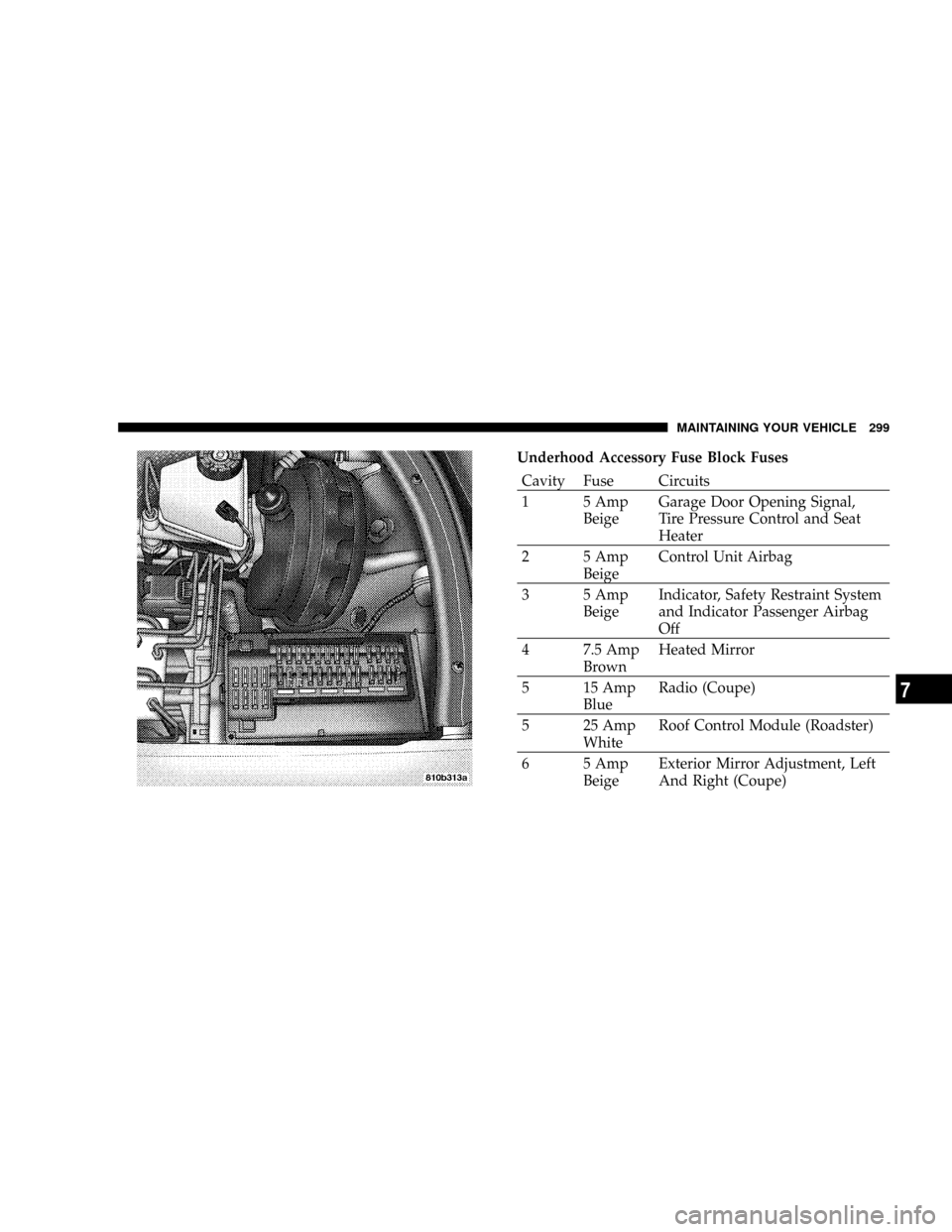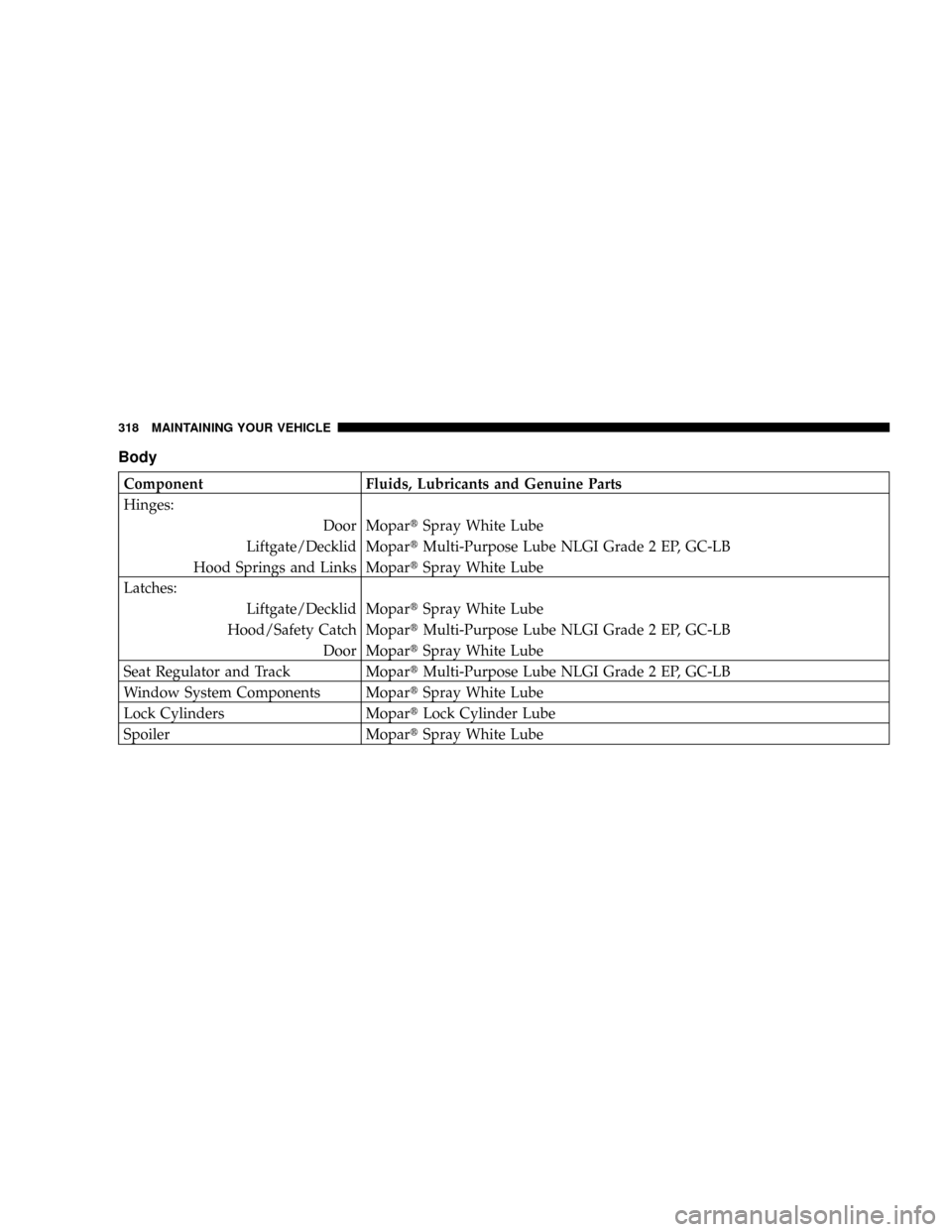2008 CHRYSLER CROSSFIRE door lock
[x] Cancel search: door lockPage 299 of 358

The following methods are sufficient if the top is only
lightly soiled:
Dry Cleaning
Brush the dry top with a soft-bristled brush from front to
rear of the vehicle.
Wet Cleaning
Wash with clear water or with a mild detergent and an
ample supply of luke warm water by wiping with a
soft-bristled brush or sponge from front to rear. Then
rinse thoroughly with clear water.
Allow the top to dry before lowering. Vacuuming the top
with a wet/dry shop vacuum will decrease the top's
drying time, ensure removal of all dirt, and delete streaks
in the material. Multiple cleanings may be necessary to
remove stubborn stains. If stains persist, contact your
local dealership for further suggestions.
Weather Strip Care
Lubricate all top and door glass weather strips periodi-
cally with Mopar Weather Strip Lubricant (part number
4773427), to keep them soft and pliable.
FUSES
Underhood Accessory Fuse Block Fuses
The underhood accessory fuse block fuses are located
under the hood on the driver's side, between the brake
master cylinder and the left front fender.
To remove the lid, squeeze the tabs together located at the
front of the fusebox. Then lift the lid up by the tabs. The
lid will then slide off the top of the fuse box. To replace
the lid, place the two hinge-like tabs at the rear of the lid
under the tabs on the fusebox. Push down on the front of
the lid until the tabs at the front click.
MAINTAINING YOUR VEHICLE 297
7
Page 301 of 358

Underhood Accessory Fuse Block Fuses
Cavity Fuse Circuits
1 5 Amp
BeigeGarage Door Opening Signal,
Tire Pressure Control and Seat
Heater
2 5 Amp
BeigeControl Unit Airbag
3 5 Amp
BeigeIndicator, Safety Restraint System
and Indicator Passenger Airbag
Off
4 7.5 Amp
BrownHeated Mirror
5 15 Amp
BlueRadio (Coupe)
5 25 Amp
WhiteRoof Control Module (Roadster)
6 5 Amp
BeigeExterior Mirror Adjustment, Left
And Right (Coupe)
MAINTAINING YOUR VEHICLE 299
7
Page 310 of 358

4. Realign the two tabs and push the light in until it
engages into the lock.Tail, Stop, Back Up and Turn Signal Lights
1. Open the rear liftgate/decklid and remove the access
door in the trim panel.
2. Twist the bulb socket counterclockwise and pull out.
3. Replace the light and return to open socket, turn
clockwise until it stops.
4. Replace the access door in the trim panel.
308 MAINTAINING YOUR VEHICLE
Page 314 of 358

Check the battery every four to six weeks to ensure that
the voltage is above 12.4 volts. Voltage will drop more
rapidly in hot temperatures. If battery voltage drops
below 12.4 volts, follow the battery recharge procedure in
the Service Manual.
²Check that the radiator coolant level of protection is to
at least -20ÉF (-29ÉC).
²Block the wheels. Do not apply the parking brake.
²Make sure that all tires are inflated to the optimum
pressure.
²Cut blocks of plywood about the same size of the tires.
Cover each block with indoor/outdoor carpeting and
place them between the tires and concrete. This will
prevent tire flat spotting.
²For long term storage, remove the tires and put the
vehicle up on blocks. Stack the tires on plywood and
cover with a tarp to prevent flat spotting.
²Move the wiper blades away from the windshield.
NOTE:To help prevent the battery from discharging
during shorter periods of inactivity, perform the follow-
ing:
1. Make sure that the rear liftgate/decklid, hood, and
doors are completely closed.
2. Make sure that the remote transmitter is operating and
that the battery is good.
3. Make sure that the hood, rear liftgate and door
switches are in adjustment.
4. Use the remote transmitter to set the alarm.
312 MAINTAINING YOUR VEHICLE
Page 320 of 358

Body
Component Fluids, Lubricants and Genuine Parts
Hinges:
Door MopartSpray White Lube
Liftgate/Decklid MopartMulti-Purpose Lube NLGI Grade 2 EP, GC-LB
Hood Springs and Links MopartSpray White Lube
Latches:
Liftgate/Decklid MopartSpray White Lube
Hood/Safety Catch MopartMulti-Purpose Lube NLGI Grade 2 EP, GC-LB
Door MopartSpray White Lube
Seat Regulator and Track MopartMulti-Purpose Lube NLGI Grade 2 EP, GC-LB
Window System Components MopartSpray White Lube
Lock Cylinders MopartLock Cylinder Lube
Spoiler MopartSpray White Lube
318 MAINTAINING YOUR VEHICLE
Page 344 of 358

ABS (Anti-Lock Brake System).............. 134
Adding Engine Coolant (Antifreeze).......... 282
Adding Fuel........................... 225
Aiming Headlights....................... 310
Air Cleaner, Engine (Engine Air Cleaner Filter) . . . 269
Air Conditioning.....................155,273
Air Conditioning Filter.................... 329
Air Conditioning Refrigerant............... 273
Air Conditioning System.................. 273
Air Pressure, Tires....................... 208
Airbag................................ 33
Airbag Deployment....................... 40
Airbag Light.........................38,140
Airbag Maintenance....................... 50
Airbag On/Off Switch...................47,53
Alignment and Balance................... 214
Antenna.............................. 154
Antifreeze (Engine Coolant)................ 315
Anti-Lock Warning Light.................. 134Appearance Care........................ 290
Ashtrays and Lighter...................... 82
Automatic Door Locks..................... 15
Automatic Transmission................174,288
Fluid and Filter Changes................. 289
Fluid Level Check...................... 288
Fluid Type........................... 288
Special Additives...................... 290
Autostick............................. 178
Ball Joints............................. 275
Battery............................135,271
Saving Feature (Protection)................ 95
Belts, Drive............................ 268
Belts, Seat.............................. 26
Body Mechanism Lubrication............... 276
B-Pillar Location........................ 203
Brake Assist System...................... 108
Brake, Parking.......................... 185
342 INDEX
Page 346 of 358

Cooling System......................... 280
Adding Coolant (Antifreeze).............. 282
Coolant Level......................... 280
Disposal of Used Coolant................ 281
Drain, Flush, and Refill.................. 281
Points to Remember.................282,283
Pressure Cap......................... 282
Rubber and Plastic Components............ 284
Selection of Coolant (Antifreeze)........... 281
Corrosion Protection..................... 290
Crankcase Emission Control System.......... 271
Cup Holder............................ 84
Customer Assistance..................... 333
Cylinders, Lock......................... 276
Dealer Service.......................... 263
Deck Lid.............................. 22
Defroster, Windshield...................... 62Disposal
Engine Oil........................... 268
Door Locks, Automatic.................... 15
Drive Belts............................ 268
Drive Shaft Universal Joints................ 275
Driving
On Slippery Surfaces.................... 182
Through Flowing, Rising, or Shallow Standing
Water.............................. 183
Electronic Speed Control (Cruise Control)....... 113
Electronic Stability Program (ESP)............ 110
Emergency, In Case of
Hazard Warning Flasher................. 232
Jump Starting......................... 241
Overheating.......................... 232
Towing............................. 245
Emergency Trunk Release................... 22
Emission Control System Maintenance......262,321
344 INDEX
Page 355 of 358

INTRODUCTION INTRODUCTION HOW TO USE THIS MANUAL WARNINGS AND CAUTIONS VEHICLE IDENTIFICATION NUMBER THINGS TO KNOW BEFORE STARTING YOUR VEHICLE A WORD ABOUT YOUR KEYS KeysObtaining Replacement KeysIgnition
Key RemovalKey-In-Ignition ReminderGLOVE COMPARTMENT LOCK DOOR LOCKS Central Locking SwitchAutomatic Central LockingGeneral Notes On the Central Locking SystemEmergency Unlocking FeatureStart LockoutREMOTE KEYLESS ENTRY To Unlock the
DoorsTo Lock The DoorsPanic AlarmTo Use the Panic AlarmGeneral InformationTransmitter Battery ServiceSECURITY ALARM SYSTEM Tow-Away AlarmDECKLID INTERNAL EMERGENCY RELEASE - ROADSTER POWER WINDOWS Power Window Operation With
The Convertible Top Switch (Roadster Only)REAR LIFTGATE/DECKLID RELEASE OCCUPANT RESTRAINTS Lap/Shoulder BeltsSeat Belts and Pregnant WomenSeat Belt ExtenderSupplemental Restraint System (SRS) - AirbagChild RestraintENGINE BREAK-IN
RECOMMENDATIONS SAFETY TIPS Exhaust GasSafety Checks You Should Make Inside the VehiclePeriodic Safety Checks You Should Make Outside the VehicleUNDERSTANDING THE FEATURES OF YOUR VEHICLE CONVERTIBLE TOP OPERATION To Lower
The TopTo Raise The TopConvertible Top Lamp and Audible Signal ChartCONSOLE FEATURES Storage Compartments (If Equipped)AshtrayCoin HolderPower Outlet/Cigar LighterGlove CompartmentCUPHOLDER (If Equipped) MIRRORS Inside Day/Night MirrorExterior
Mirrors Folding FeatureHeated Remote Control Mirrors (If Equipped)Outside MirrorsPower Remote Control Outside MirrorsVanity Mirrors SEATS Manual Seat Adjustments (If Equipped)Driver Eight-Way Power Seat (If Equipped)Passenger Four-Way Power Seat (If Equipped)
Heated Seats (If Equipped)TO OPEN AND CLOSE THE HOOD INTERIOR LIGHTS Front Map/Reading LightsBattery Saver FeatureInstrument Panel LightingNightSecurity IlluminationEXTERIOR LIGHTS Headlights and Parking LightsDaytime Running Lights (Where
Applicable)Fog Lights (If Equipped)Standing LightsMULTIFUNCTION CONTROL LEVER Turn SignalsHeadlight Dimmer SwitchPassing LightWindshield Wipers And WasherMist FunctionTELESCOPING STEERING COLUMN REAR SPOILER BRAKE ASSIST SYSTEM
(BAS) ELECTRONIC STABILITY PROGRAM (ESP) Synchronizing ESPELECTRONIC SPEED CONTROL To Vary The Speed SettingTo DeactivateTo Resume SpeedUsing Speed Control On HillsGARAGE DOOR OPENER (If Equipped) Programming The Universal
TransceiverGate Operator/Canadian ProgrammingUsing the Universal TransceiverErasing Universal Transceiver ButtonsReprogramming a Single ButtonSecurityUMBRELLA HOOK UNDERSTANDING YOUR INSTRUMENT PANEL INSTRUMENTS AND CONTROLS
NSTRUMENT CLUSTER INSTRUMENT CLUSTER DESCRIPTION INFINITY MODULUS AM/FM STEREO RADIO WITH SINGLE-DISC CD PLAYER AND GPS NAVIGATION AM/FM STEREO RADIO WITH SINGLE-DISC CD PLAYER INFINITY MODULUS Entertainment
SystemsCD Player OperationUser MenuUser Memory (USER - 1, 2, 3)Mono/StereoDriver - L/RTelephone mute characteristicsCOMPACT DISC MAINTENANCE RADIO ANTENNA RADIO OPERATION AND CELLULAR PHONES CLIMATE CONTROLS Temperature Control
Fan ControlBasic Setting - HeaterBasic Setting - Air ConditionerDust Filter (If Equipped)Operating Tips STARTING AND OPERATING STARTING PROCEDURES Normal StartingExtremely Cold Weather (below -20 degrees F or -29 degrees C)If Engine Fails to StartAfter
StartingTRANSMISSION SHIFTING Manual Transmission Recommended Shift SpeedsAutomatic Transmission StoppingManeuveringPark PositionReverseNeutralDriveAutoStick Gear selectionGear RangesProgram mode selector switchEmergency Operation (Limp Home
Mode)DRIVING ON SLIPPERY SURFACES Traction DRIVING THROUGH WATER Flowing/Rising WaterPARKING BRAKE BRAKE SYSTEM Brake Assist System (BAS)Electronic Stability Program (ESP)Synchronizing ESPESP Control switchAnti-Lock Brake System (ABS)
Brake Pad Break-InPOWER STEERING TIRE SAFETY INFORMATION TIRE MARKINGS TIRE LOADING AND TIRE PRESSURETIRES - GENERAL INFORMATION Tire PressureTire Inflation PressuresTire Pressures For High Speed OperationRadial-Ply TiresTire Spinning
Tread Wear IndicatorsLife Of TireReplacement TiresAlignment And BalanceTIRE PRESSURE MONITOR SYSTEM General InformationTIRE CHAINS ORIGINAL EQUIPMENT TIRES SNOW TIRES TIRE ROTATION RECOMMENDATIONS FUEL REQUIREMENTS
Reformulated GasolineGasoline/Oxygenate BlendsMMT in GasolineMaterials Added to FuelSulfur in GasolineADDING FUEL Fuel Filler Cap (Gas Cap)VEHICLE LOADING Roof Luggage RackTRAILER TOWING WHAT TO DO IN EMERGENCIES HAZARD WARNING
FLASHER IF YOUR ENGINE OVERHEATS TIREFIT TIRE REPAIR AND JACKING TIREFITPreparations for JackingJack Location and Instructions JUMP-STARTING THEBATTERY FREEING A STUCK VEHICLE TOWING A DISABLED VEHICLE Towing EyesTow-Away
AlarmCONVERTIBLE TOP EMERGENCY OPERATION Relieving Hydraulic PressureOpening a Locked DecklidMAINTAINING YOUR VEHICLE 3.2L ENGINE ONBOARD DIAGNOSTIC SYSTEM (OBD II) EMISSIONS INSPECTION AND MAINTENANCE PROGRAMS
REPLACEMENT PARTS AUTHORIZED DEALER SERVICE MAINTENANCE PROCEDURES Engine OilIgnition Wiring SystemCrankcase Emission Control SystemMaintenance-Free BatteryAir ConditionerPower Steering FluidChassis LubricationBody LubricationWindshield
Wiper BladesWindshield Wiper Blade ReplacementWindshield Washer ReservoirExhaust SystemCooling SystemHoses And Vacuum/Vapor HarnessesBrakesAutomatic TransmissionManual TransmissionAppearance Care and Protection from CorrosionCONVERTIBLE TOP
CARE WashingGeneral CleaningWeather Strip CareFUSES Underhood Accessory Fuse Block FusesRelay Control Module Fuses Interior Fuses REPLACEMENT BULBS Interior Light BulbsExterior Light BulbsEXTERIOR LIGHT BULB SERVICE HeadlightsFront Turn Signal
and Parking/Standing LightsFront and Rear Sidemarker LightsTail, Stop, Back Up and Turn Signal LightsLicense Plate LightHeadlight AimingVEHICLESTORAGE SPECIFICATIONS FLUID CAPACITIES RECOMMENDED FLUIDS, LUBRICANTS AND GENUINE PARTS
EngineChassisBodyMAINTENANCE SCHEDULES INTRODUCTION WARRANTY EMISSION CONTROL SYSTEM MAINTENANCE MAINTENANCE SCHEDULES SCOPE OF WORK FOR A SCHEDULE MAINTENANCE SERVICESCOPE OF WORK FOR B SCHEDULE
MAINTENANCE SERVICEFSS SYSTEM REGULAR CHECK-UPS Additional Periodic MaintenanceSPECIAL MAINTENANCE REQUIREMENTS CoolantDust Filter for Heating/Ventilation Replacement (If Equipped)ENGINE OIL CHANGE AND FILTER REPLACEMENT IF
YOU NEED CONSUMER ASSISTANCE SUGGESTIONS FOR OBTAINING SERVICE FOR YOUR VEHICLE Prepare For The AppointmentPrepare A ListBe Reasonable With RequestsIF YOU NEED ASSISTANCE Chrysler Motors LLC Customer CenterChrysler Canada
Inc. Customer CenterIn Mexico contactCustomer Assistance For The Hearing Or Speech Impaired (TDD/TTY)Service ContractWARRANTY INFORMATION (U.S. Vehicles Only) MOPAR PARTS REPORTING SAFETY DEFECTS In The 50 United States And Washington,
D.CIn CanadaPUBLICATION ORDER FORMS DEPARTMENT OF TRANSPORTATION UNIFORM TIRE QUALITY GRADES TreadwearTraction GradesTemperature GradesINDEX